Nikon Coolpix 5200: Does It Deliver?
by Stephen Caston on July 23, 2004 12:05 AM EST- Posted in
- Digital Camera
The Design: Nikon Coolpix 5200
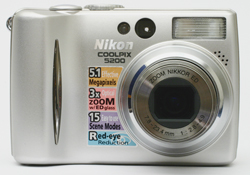
88 x 50 x 36.5mm
Click to enlarge.
The front of the Nikon Coolpix 5200 features a Nikkor ED lens capable of a 38 - 114mm (35mm equivalent) optical zoom and a 4x digital zoom. Nikon developed their ED (Extra-low Dispersion) lenses to help reduce chromatic aberration while delivering rich color and sharp image quality. This lens is also capable of shutter speeds from 4 - 1/2000 sec. and an aperture range of f2.8 - 4.9. The lens is protected by a built-in cover that opens automatically when the camera is powered on and closes when the camera is powered off. Just to the right of the lens is a small microphone. Above the microphone is the flash with a range of 1' - 14.7' in wide angle and 1' - 11.4' in telephoto. To the left of the flash are the viewfinder window and AF assist/Self-timer lamp. We are continually impressed with Nikon's ability to make compact cameras so easy to hold. Even on a camera as small as the Coolpix 5200, there is a decent-size hand grip on the left side of the camera.
The back of the CP5200 houses its 1.5" LCD monitor with 110,000 pixels. The monitor can be adjusted to 5 levels of brightness available through the Set up mode. Above the LCD are the viewfinder, a green AF indicator lamp, and a red Flash indicator lamp. Just below the monitor are 3 dedicated buttons: Delete, Menu, and Play. On the right side of the monitor is a 4-way arrow pad with a dedicated "Enter" button in the middle. Below the arrow pad is a speaker, which is used to play back audio from movie clips and voice memos. The zoom controls for the lens can be found at the upper right hand corner. When holding the camera, our thumb naturally found a resting place on the zoom controller, and we found it relatively easy to reach the arrow pad without repositioning our hand.
When looking at the camera from the top, you will see the Mode dial, Shutter-release button, Power-on lamp, and On/Off button. The Mode dial is used to access different shooting modes and the main Setup screen. The Shutter-release button is pretty standard: half-press to focus and full press to shoot. The camera can be turned on in two different ways. To power up in Record mode and extend the lens, you simply press the On/Off button. However, if you wish to enter Playback mode without extending the lens, you can hold down the Play button for two seconds. To power down the camera, you must press the On/Off button. Whenever the camera is on, the Power-on lamp will be lit. However, if the camera is left on for 1 minute without being used, the camera will enter standby mode and the light will blink for 3 minutes until the camera powers itself down. The amount of time before the camera enters standby mode can be changed to 30 sec, 1, 5, or 30 minutes.
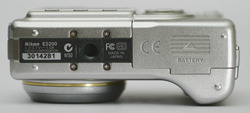 Click to enlarge. |
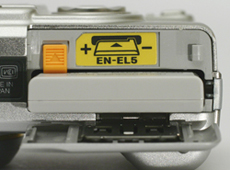 Click to enlarge. |
There is a plastic tripod mount on the bottom of the camera. The battery compartment is on the right side behind a sliding spring-action door. The CP5200 uses a rechargeable EN-EL5 Lithium-Ion battery (3.7V 1100mAh), which is included in the box.
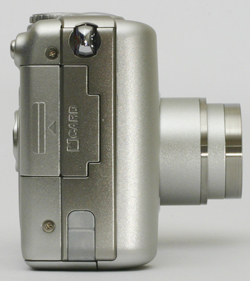 Click to enlarge. |
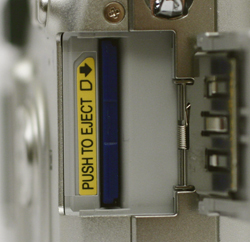 Click to enlarge. |
On the right side of the camera are a wrist strap post, a sliding spring-action door that covers the SD flash card slot, and a tab that can be moved out of the way to make room for the optional AC adaptor. The CP5200 supports SD flash cards.
The only thing on the left side of the camera is a combination USB and A/V out port.


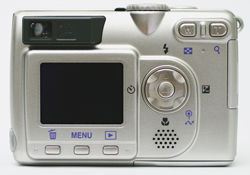
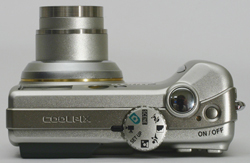









5 Comments
View All Comments
FFS - Thursday, July 29, 2004 - link
ANANDECH Please stick to HARDWARE REVIEWSThere much better sites over Internet for DigiCams reviews... You just could not compete with there competence.
Do not make the same mistake as TomsHardware guide did.
What would be next - Games... :(((
That is my POINT OF VIEW
And I'm also very disappointed (to say at least)
Thou not about english, my is not perfect as well.
WooDaddy - Friday, July 23, 2004 - link
Ok.. I guess..You might not what to make up a phrase like that and instead just call it what it is; play to record transition. That's the term that is widely accepted and would prevent confusion.
From other reviews I've seen on the 5200, this 'feature' exists and there are timings for this as well. Maybe try a full press .. or read the manual. Nikon probably uses a different method for switching between play and record modes. Each manufacturer is different... and their customers know this.
It's upsetting that I have to look to other reviews to validate or invalidate what you're written.
(Also, it's "Timing", not "The Times". Simple 8th grade grammar. And yes, I'm pissed again..)
stephencaston - Friday, July 23, 2004 - link
WooDaddy: When I say shooting priority, I am not referring to Shutter Priority. I am referring to when a half-press of the shutter button will switch the camera back to shooting mode from playback mode, menus, etc. Shooting priority means the camera's priority is to take pictures as opposed to reviewing pictures or changing menu options.Sorry for the confusion
WooDaddy - Friday, July 23, 2004 - link
You know I had to say something...Better, has potential. A few comments though:
The garbage dumpster in the parking lot... Come on man. That's a horrible subject. You can do better. Would you show that to your friends and say "Hey look at this cool picture!". I think not.
Shooting-priority - There is no such thing. You probably saw it somewhere but it is a poorly chosen marketing term. There are only four types of exposure based shooting: aperture, SHUTTER, manual and full auto. Think about it.. Shooting-priority. Shooting priority over what? Not shooting? It's a marketing term gone awry.
Even though you are showcasing the Nikon, you should still have a reference point from another similarly marketed camera from another company. I mentioned this in my last post. Even though this is not a camera roundup, it still applies here as well.
I can tell from your subjects (the subjects in your photos) and your commentary that you are still new to photography as a whole. A REALLY OUTSTANDING book is Photography by Barbara London and John Upton. It's about $86 but it is a great book for beginners and pros alike. It's the standard textbook that all photographers use. If you want some suggestions for subjects, I can be of help. PM me and I promise not to bite.
The final word didn't really convince me. The features you mentioned as being good are features that most 5mp have or should have and nothing that stands out. Try out the Minolta G500 as it is a similar camera. Compare them and I bet you'll see what I mean. Also, use dpreview.com. Compare their reviews to steves-digicams and imaging-resource.com. You'll see the WIDE difference between them from dpreview.com. The level of professionalism and inherent photography skill vs gadget love is obvious. I want you to decide which side you want to be on. It seems like you'd like to be a dpreview editor but I think based on AT's focus, you might just want to focus on prices, features and that's it. Most of us know about dpreview and will go there.
It'll take some time, but you'll get there...
And I promise, I'll be less harsh as time goes on. Us photogs can be ruthless ;)
LoneWolf15 - Friday, July 23, 2004 - link
For about $100 less, one can get the Fuji Finepix S5000, which has lower resolution (3.1MP) but compensates by having a 10x optical zoom, aperture priority, shutter priority, and full manual, as well as a digital TTL viewfinder. It has 6MP resolution with interpolation, which I wouldn't use, but I think you get more for the money overall.